View in other NatureServe Network Field Guides
NatureServe
Montana
Utah
Wyoming
Idaho
Wisconsin
British Columbia
South Carolina
Yukon
California
New York
Yellow Sweetclover - Melilotus officinalis
Non-native Species
Global Rank:
GNR
State Rank:
SNA
(see State Rank Reason below)
C-value:
0
Agency Status
USFWS:
USFS:
BLM:
External Links
State Rank Reason (see State Rank above)
Melilotus officinalis is native to Europe and western Asia and was introduced into North America (Turkington et al. 1978). A conservation status rank is not applicable (SNA) because the plant is an exotic (non-native) in Montana and is not a suitable target for conservation activities.
General Description
PLANTS: Herbaceous biennial from a taproot (rarely annual or perennial). Erect, single-stemmed in the first year; multi-stemmed and more robust in the second year. Stems are glabrous to pubescent and typically 50-100 cm tall. Sources: Gucker 2009; Lesica et al. 2012; Darbyshire and Small 2018.
LEAVES: Alternately arranged on the stem and trifoliate (3-leaflets). Leaflets oblong, 1-3 cm long, typically smooth, and serrated on margins to near the base. Source: Whitson et al. 1996; Lesica et al. 2012.
INFLORESCENCE: Yellow flowers arranged in a narrow raceme, 5-16 cm long, that arises from leaf axils. Each raceme supports 20-80 flowers and is minutely bracteate (2 mm). Flowers are pea-like, strongly sweet-scented, 4-6 mm long, nodding, and yellow (turning cream to white with age). Calyx is about 2 mm long with linear lobes. Fruit is a legume, ovoid, 3-4 mm long, scarcely dehiscent, and usually one-seeded. Sources: Gucker 2009; Lesica et al. 2012; Darbyshire and Small 2018.
The genus Melilotus comes from meli, which is the Greek word for honey, and lotus which refers to a 'clover-like plant'.
Phenology
Flowering in early summer through fall (Gucker 2009).
Diagnostic Characteristics
Yellow Sweetclover –
Melilotus officinalis, exotic
* Flowers: yellow.
* Racemes: greater than 4 cm long. At peak flowering racemes are 6 times as long as wide.
* Leaflets: 3. Margins serrated more than half-way to the base. Leaflets usually no more than 2 times longer than broad.
* Fruits (legume): surface has elongated ridges (veins) that delimit spaces (areolae), and these spaces tend to be longer than wide.
White Sweetclover –
Melilotus albus, exotic
* Flowers: white.
* Racemes: greater than 4 cm long. At peak flowering racemes are 8-15 times as long as wide.
* Leaflets: 3. Margins serrated more than half-way to the base. Leaflets 2.5-3.5 times as long as broad.
* Fruits (legume): surface has shorter ridges (veins) that delimit spaces (areolae), and these spaces tend to be as long as wide.
* Habitat: In Montana there is a tendency for White Sweetclover to grow more commonly in riparian areas and in slightly moister sites.
Alfalfa –
Medicago sativa, exotic
* Flowers: purple or white.
* Racemes: less than 3 cm long.
* Fruits (legume): surface texture is veiny; coiled or curved with more than one seed.
* Leaflets: 3. Margins serrated in upper half of leaflet. Oblanceolate.
TAXONOMYYellow Sweetclover and White Sweetclover share similar appearances, except for their flower color, which has caused many botanists to conclude they are of the same species (conspecific) (Kartesz 2015; USDA PLANTS Database [NRCS 2022]; IT IS 2017; Bugwood 2017). However,
Darbyshire and Small (2018) report evidence that these two species are evolutionarily separate and genetically more closely related to other species in the genus than they are to each other. Breeding studies have shown that there are strong physiological barriers to fertilization, and when crossed Yellow and White Sweetclovers rarely produce fertile progeny (Darbyshire and Small 2018). Differences found in their phenology, ecology, physiology/biochemistry, seed protein profiles, chromosome structure, and DNA sequences support the theory that they evolved separately from one another (Darbyshire and Small 2018). Hence, Darbyshire and Small (2018) support the treatment that Yellow Sweetclover and White Sweetclover are separate species.
Species Range
Montana Range
Range Descriptions
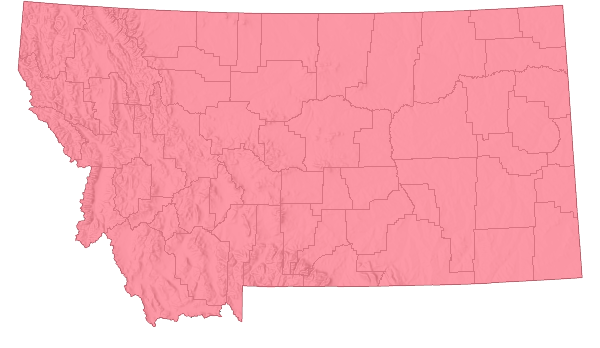
 Non-native
Non-native
Range Comments
Yellow Sweetclover's native range spans the Mediterranean region of central Europe to Tibet. Yellow Sweetclover has been naturalized in Ireland, throughout Europe and Asia to western China (Turkington et al. 1978)
Melilotus was first reported in North America in 1664. By the early 20th century, it had been cultivated in nearly every state.
The earliest Montana herbarium specimen on the Consortium of the Pacific Northwest Herbaria portal was collected from Helena in 1887 (accessed on May 14, 2022 from (https://www.pnwherbaria.org).
Observations in Montana Natural Heritage Program Database
Number of Observations: 2042
(Click on the following maps and charts to see full sized version)
Map Help and Descriptions
Relative Density
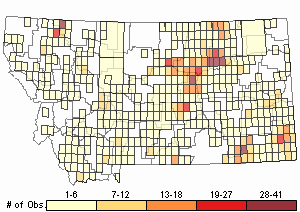
Recency
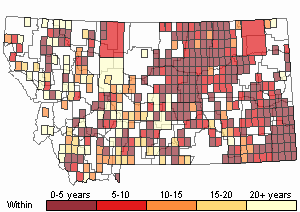

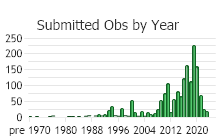
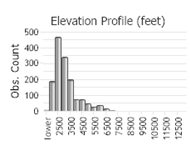 (Observations spanning multiple months or years are excluded from time charts)
(Observations spanning multiple months or years are excluded from time charts)
Habitat
Commonly found in disturbed sites including agricultural fields, roadsides, mining spoils, borrow pits, rangelands, open slopes in badlands, prairies, floodplains, and recently burned areas. Plants are found in the plains and valley zones of Montana (Lesica et al. 2012).
Ecology
ECOLOCIAL TOLERANCEYellow Sweetclover plants establish and grow under a wide range of temperatures and precipitation rates, and on a variety of alkaline to slightly acidic soils and parent materials (Gucker 2009). Very low nutrient levels and fine to coarse-textured soils are tolerated. Moist soil conditions are essential for seed germination; however, once established, plants are drought tolerant and capable of completing their lifecycle (Gucker 2009).
SUCCESSIONYellow Sweetclover is a often one of the first plants to appear when ground is disturbed (Whitson et al. 1996). Plants help to stabilize soils (Whitson et al. 1996).
POLLINATORSBees (honeybees, bumble bees, and leaf-cutter bees) are the most common pollinators of sweetclover (Gucker 2009). Wasps, flies, and other insects are less common pollinators (Gucker 2009).
The following insect species have been reported as pollinators of Yellow Sweetclover or other
Melilotus species where their geographic ranges overlap::
Bombus vagans,
Bombus appositus,
Bombus bifarius,
Bombus borealis,
Bombus centralis,
Bombus fervidus,
Bombus huntii,
Bombus nevadensis,
Bombus rufocinctus,
Bombus sylvicola,
Bombus ternarius,
Bombus terricola,
Bombus occidentalis,
Bombus bimaculatus,
Bombus griseocollis,
Bombus impatiens,
Bombus insularis,
Bombus suckleyi,
Bombus bohemicus, and
Bombus flavidus (Macior 1974, Thorp et al. 1983, Johnson 1986, Colla and Dumesh 2010, Wilson et al. 2010, Colla et al. 2011, Koch and Strange 2012, Koch et al. 2012, Williams et al. 2014, Miller-Struttmann and Galen 2014).
Reproductive Characteristics
Plants reproduce by seed.
FLOWERS
Perfect (containing male and female organs). Calyx lobes are subequal, about 2 mm long. The sweet-scented pea-like flowers are bilaterally symmetrical, yellow, and 4-6 mm long, with 10 stamens (9 united and 1 separate).
FRUITS
An ovoid legume, 3-4 mm long, scarcely dehiscent, and mostly containing one seed.
LIFE CYCLE [Adapted from Gucker 2009]
Yellow Sweetclover germinates in spring. During the first year of growth, a single, vegetative stem with many branches is produced. Near the end of the first growing season, nutrients are allocated below ground to the taproot and root crown buds are formed. In the second year of growth, the number of stems increases, the plant grows larger, and flowers and seeds are produced.
Flowering commences in early summer and may continue throughout the growing season. Seeds develop from mid-summer to fall. A single plant can produce thousands of viable seeds. Melilotus generally produces both readily germinable and water-impermeable or "hard" seeds; the latter capable of persisting in the seed bank for a decade or more and requiring scarification to germinate. Seeds are commonly dispersed by rainwater runoff and stream flow, with animals occasionally moving seeds around (especially humans).
Management
From an agricultural perspective Yellow Sweetclover and White Sweetclover have many uses while also can be problematic for farmers, livestock management, and in restoration.
CULTIVATIONThe planting and use of
Melilotus species has been widely promoted for soil stabilization and reclamation, production of high-protein forage, production of honey, and a host of other uses. Yellow Sweetclover is less often used as an agricultural crop compared to White Sweetclover (Turkington et al. 1978).
Sweetclovers that grow in wheat fields can cause sweetclover taint, whereby harvested wheat absorbs the characteristic odor of sweetclover (Turkington et al. 1978). This happens when sweetclover is still green or conditions are wet during wheat harvesting.
GRAZING MANAGEMENTYellow and White Sweetclovers are high in coumarin which causes anticoagulation of the blood (Whitson et al. 1996). This compound can cause bloat in cattle (Whitson et al. 1996). Feeding cattle spoiled sweetclover hay can cause sweetclover disease or 'bleeding disease' (Turkington et al. 1978). Commercially available varieties of these species planted for forage have been developed to produce lower levels of coumarin and are less likely to cause bloat (Whitson et al. 1996).
Useful Links:Montana Invasive Species websiteMontana Biological Weed Control Coordination ProjectMontana Department of Agriculture - Noxious WeedsMontana Weed Control AssociationMontana Weed Control Association Contacts Webpage.
Montana Fish, Wildlife, and Parks - Noxious WeedsMontana State University Integrated Pest Management ExtensionWeed Publications at Montana State University Extension - MontGuidesStewardship Responsibility
Threats or Limiting Factors
In more recent times, efforts have begun to control the sweetclover populations because they can have negative impacts to agricultural crops (associated with viral plant diseases), can quickly and abundantly invade natural habitats, shade native vegetation, alter soil nitrogen levels, and initiate shifts in native species composition (Gucker 2009).
In roadsides Yellow Sweetclover plants can grow abundantly and very tall, often masking guard rails and road signs which creates potential problems for motorists (Turkington et al. 1978).
References
- Literature Cited AboveLegend:
 View Online Publication
View Online Publication Bugwood Network, USDA Forest Service, and USDA Aphis Ppq. 2017. Invasive Species Website. https://www.bugwood.org/
Bugwood Network, USDA Forest Service, and USDA Aphis Ppq. 2017. Invasive Species Website. https://www.bugwood.org/ Colla, S., L. Richardson, and P. Williams. 2011. Bumble bees of the eastern United States. Washington, DC: USDA Forest Service, Pollinator Partnership. 103 p.
Colla, S., L. Richardson, and P. Williams. 2011. Bumble bees of the eastern United States. Washington, DC: USDA Forest Service, Pollinator Partnership. 103 p. Colla, S.R. and S. Dumesh. 2010. The bumble bees of southern Ontario: notes on natural history and distribution. Journal of the Entomological Society of Ontario 141:39-68.
Colla, S.R. and S. Dumesh. 2010. The bumble bees of southern Ontario: notes on natural history and distribution. Journal of the Entomological Society of Ontario 141:39-68. Darbyshire, S. and E. Small. 2018. Are Melilotus albus and M. officinalis conspecific? Genetic Resources and Crop Evolution 65:1571-1580.
Darbyshire, S. and E. Small. 2018. Are Melilotus albus and M. officinalis conspecific? Genetic Resources and Crop Evolution 65:1571-1580. Gucker, C.L. 2009. Melilotus alba, M. officinalis. In: Fire Effects Information System, [Online]. U.S. Department of Agriculture, Forest Service, Rocky Mountain Research Station, Fire Sciences Laboratory (Producer).
Gucker, C.L. 2009. Melilotus alba, M. officinalis. In: Fire Effects Information System, [Online]. U.S. Department of Agriculture, Forest Service, Rocky Mountain Research Station, Fire Sciences Laboratory (Producer). Integrated Taxonomic Information System (ITIS 2017). May 17, 2022 last update from the Integrated Taxonomic Information System (ITIS) on-line database, www.itis.gov, https://doi.org/10.5066/F7KH0KBK
Integrated Taxonomic Information System (ITIS 2017). May 17, 2022 last update from the Integrated Taxonomic Information System (ITIS) on-line database, www.itis.gov, https://doi.org/10.5066/F7KH0KBK Johnson, R.A. 1986. Intraspecific resource partitioning in the bumble bees Bombus ternarius and B. pennsylvanicus. Ecology 67:133-138.
Johnson, R.A. 1986. Intraspecific resource partitioning in the bumble bees Bombus ternarius and B. pennsylvanicus. Ecology 67:133-138. Kartesz, J.T. 2015. The Biota of North America Program (BONAP) North American Plant Atlas. Chapel Hill, N.C. [maps generated from Kartesz, J.T. 2015. Floristic Synthesis of North America, Version 1.0. Biota of North America Program (BONAP). (in press)].
Kartesz, J.T. 2015. The Biota of North America Program (BONAP) North American Plant Atlas. Chapel Hill, N.C. [maps generated from Kartesz, J.T. 2015. Floristic Synthesis of North America, Version 1.0. Biota of North America Program (BONAP). (in press)]. Koch, J., J. Strange, and P. Williams. 2012. Bumble bees of the western United States. Washington, DC: USDA Forest Service, Pollinator Partnership. 143 p.
Koch, J., J. Strange, and P. Williams. 2012. Bumble bees of the western United States. Washington, DC: USDA Forest Service, Pollinator Partnership. 143 p. Koch, J.B. and J.P. Strange. 2012. The status of Bombus occidentalis and B. moderatus in Alaska with special focus on Nosema bombi incidence. Northwest Science 86:212-220.
Koch, J.B. and J.P. Strange. 2012. The status of Bombus occidentalis and B. moderatus in Alaska with special focus on Nosema bombi incidence. Northwest Science 86:212-220. Lesica, P., M.T. Lavin, and P.F. Stickney. 2012. Manual of Montana Vascular Plants. Fort Worth, TX: BRIT Press. viii + 771 p.
Lesica, P., M.T. Lavin, and P.F. Stickney. 2012. Manual of Montana Vascular Plants. Fort Worth, TX: BRIT Press. viii + 771 p. Macior, L.M. 1974. Pollination ecology of the Front Range of the Colorado Rocky Mountains. Melanderia 15: 1-59.
Macior, L.M. 1974. Pollination ecology of the Front Range of the Colorado Rocky Mountains. Melanderia 15: 1-59. Miller-Struttmann, N.E. and C. Galen. 2014. High-altitude multi-taskers: bumble bee food plant use broadens along an altitudinal productivity gradient. Oecologia 176:1033-1045.
Miller-Struttmann, N.E. and C. Galen. 2014. High-altitude multi-taskers: bumble bee food plant use broadens along an altitudinal productivity gradient. Oecologia 176:1033-1045. Thorp, R.W., D.S. Horning, and L.L. Dunning. 1983. Bumble bees and cuckoo bumble bees of California (Hymenoptera: Apidae). Bulletin of the California Insect Survey 23:1-79.
Thorp, R.W., D.S. Horning, and L.L. Dunning. 1983. Bumble bees and cuckoo bumble bees of California (Hymenoptera: Apidae). Bulletin of the California Insect Survey 23:1-79. Turkington, R.A., P.B. Cavers, and E. Rempel. 1978. The biology of Canadian weeds. 29. Melilotus alba Desr. and M. officinalis (L.) Lam. Canadian Journal of Plant Science 58:523-537.
Turkington, R.A., P.B. Cavers, and E. Rempel. 1978. The biology of Canadian weeds. 29. Melilotus alba Desr. and M. officinalis (L.) Lam. Canadian Journal of Plant Science 58:523-537. USDA, NRCS. 2022. The PLANTS Database (http://plants.usda.gov, 05/31/2022). National Plant Data Team, Greensboro, NC USA.
USDA, NRCS. 2022. The PLANTS Database (http://plants.usda.gov, 05/31/2022). National Plant Data Team, Greensboro, NC USA. Williams, P., R. Thorp, L. Richardson, and S. Colla. 2014. Bumble Bees of North America. Princeton, NJ: Princeton University Press. 208 p.
Williams, P., R. Thorp, L. Richardson, and S. Colla. 2014. Bumble Bees of North America. Princeton, NJ: Princeton University Press. 208 p. Wilson, J.S., L.E. Wilson, L.D. Loftis, and T. Griswold. 2010. The montane bee fauna of north central Washington, USA, with floral associations. Western North American Naturalist 70(2): 198-207.
Wilson, J.S., L.E. Wilson, L.D. Loftis, and T. Griswold. 2010. The montane bee fauna of north central Washington, USA, with floral associations. Western North American Naturalist 70(2): 198-207.
- Additional ReferencesLegend:
 View Online Publication
View Online Publication
Do you know of a citation we're missing? Adhikari, S. 2018. Impacts of dryland farming systems on biodiversity, plant-insect interactions, and ecosystem services. Ph.D. Dissertation. Bozeman, MT: Montana State University. 207 p.
Adhikari, S. 2018. Impacts of dryland farming systems on biodiversity, plant-insect interactions, and ecosystem services. Ph.D. Dissertation. Bozeman, MT: Montana State University. 207 p. Ament, R.J. 1995. Pioneer Plant Communities Five Years After the 1988 Yellowstone Fires. M.Sc. Thesis. Bozeman, MT: Montana State University. 216 p.
Ament, R.J. 1995. Pioneer Plant Communities Five Years After the 1988 Yellowstone Fires. M.Sc. Thesis. Bozeman, MT: Montana State University. 216 p. Bess, J.A. 1997. The leafhopper species assemblages associated with native and replanted grasslands in southwest Montana. M.Sc. Thesis. Bozeman, Montana: Montana State University. 94 p.
Bess, J.A. 1997. The leafhopper species assemblages associated with native and replanted grasslands in southwest Montana. M.Sc. Thesis. Bozeman, Montana: Montana State University. 94 p. Boggs, K. W. 1984. Succession in riparian communities of the lower Yellowstone River, Montana. M.S. Thesis. Montana State University, Bozeman, 107 pp.
Boggs, K. W. 1984. Succession in riparian communities of the lower Yellowstone River, Montana. M.S. Thesis. Montana State University, Bozeman, 107 pp. Butler, M.A. 1996. The validity of using artificial nests to assess nest-predation rates in prairie nesting ducks. M.Sc. Thesis. Bozeman, MT: Montana State University. 82 p.
Butler, M.A. 1996. The validity of using artificial nests to assess nest-predation rates in prairie nesting ducks. M.Sc. Thesis. Bozeman, MT: Montana State University. 82 p. Chadde, S.W. 1985. Initial recovery patterns of southwestern Montana foothill range. M.Sc. Thesis. Bozeman, MT: Montana State University. 103 p.
Chadde, S.W. 1985. Initial recovery patterns of southwestern Montana foothill range. M.Sc. Thesis. Bozeman, MT: Montana State University. 103 p. Clark, D. 1991. The effect of fire on Yellowstone ecosystem seed banks. M.Sc. Thesis. Montana State University, Bozeman. 115 pp.
Clark, D. 1991. The effect of fire on Yellowstone ecosystem seed banks. M.Sc. Thesis. Montana State University, Bozeman. 115 pp. Consortium of Pacific Northwest Herbaria (CPNWH) Specimen Database. No Date. Plant specimen data displayed on the PNW Herbaria portal. Website http://www.pnwherbaria.org.
Consortium of Pacific Northwest Herbaria (CPNWH) Specimen Database. No Date. Plant specimen data displayed on the PNW Herbaria portal. Website http://www.pnwherbaria.org. Corr, D.R. 1988. Effects of stress inducing factors on musk thistle (Carduus nutans L,) including--grass competition, Rhinocyllus conicus Froel., terminal flower loss, and insecticides. M.Sc. Thesis. Bozeman, MT: Montana State University. 86 p.
Corr, D.R. 1988. Effects of stress inducing factors on musk thistle (Carduus nutans L,) including--grass competition, Rhinocyllus conicus Froel., terminal flower loss, and insecticides. M.Sc. Thesis. Bozeman, MT: Montana State University. 86 p. Culver, D.R. 1994. Floristic analysis of the Centennial Region, Montana. M.Sc. Thesis. Montana State University, Bozeman. 199 pp.
Culver, D.R. 1994. Floristic analysis of the Centennial Region, Montana. M.Sc. Thesis. Montana State University, Bozeman. 199 pp. Dillard, S.L. 2019. Restoring semi-arid lands with microtopography. M.Sc. Thesis. Bpzeman, MT: Montana State University. 97 p.
Dillard, S.L. 2019. Restoring semi-arid lands with microtopography. M.Sc. Thesis. Bpzeman, MT: Montana State University. 97 p. DuBois, K.L. 1979. An inventory of the avifauna in the Long Pines of Southeastern Montana. M.Sc. Thesis. Bozeman, MT: Montana State University. 113 p.
DuBois, K.L. 1979. An inventory of the avifauna in the Long Pines of Southeastern Montana. M.Sc. Thesis. Bozeman, MT: Montana State University. 113 p. Eggers, M.J.S. 2005. Riparian vegetation of the Montana Yellowstone and cattle grazing impacts thereon. M.Sc. Thesis. Montana State University, Bozeman, MT. 125 p.
Eggers, M.J.S. 2005. Riparian vegetation of the Montana Yellowstone and cattle grazing impacts thereon. M.Sc. Thesis. Montana State University, Bozeman, MT. 125 p. Fogelsong, M.L. 1974. Effects of fluorides on Peromyscus maniculatus in Glacier National Park. M.Sc. Thesis. Bozeman, Montana: Montana State University. 52 p.
Fogelsong, M.L. 1974. Effects of fluorides on Peromyscus maniculatus in Glacier National Park. M.Sc. Thesis. Bozeman, Montana: Montana State University. 52 p. Foster, J.W. 1977. Impact of off-road vehicle traffic on soils and vegetation on rangeland in southeastern Montana and photographic monitoring of the effects. M.Sc. Thesis. Bozeman, MT: Montana State University. 168 p.
Foster, J.W. 1977. Impact of off-road vehicle traffic on soils and vegetation on rangeland in southeastern Montana and photographic monitoring of the effects. M.Sc. Thesis. Bozeman, MT: Montana State University. 168 p. Fritzen, D.E. 1995. Ecology and behavior of Mule Deer on the Rosebud Coal Mine, Montana. Ph.D. Dissertation. Bozeman, MT: Montana State University. 143 p.
Fritzen, D.E. 1995. Ecology and behavior of Mule Deer on the Rosebud Coal Mine, Montana. Ph.D. Dissertation. Bozeman, MT: Montana State University. 143 p. Harvey, S.J. 1990. Responses of steppe plants to gradients of water soil texture and disturbance in Montana, U.S.A. Ph.D. Thesis. Bozeman, MT: Montana State University. 34 p.
Harvey, S.J. 1990. Responses of steppe plants to gradients of water soil texture and disturbance in Montana, U.S.A. Ph.D. Thesis. Bozeman, MT: Montana State University. 34 p. Hodgson, J.R. 1970. Ecological distribution of Microtus montanus and Microtus pennsylvanicus in an area of geographic sympatry in southwestern Montana. Ph.D. Dissertation. Bozeman, Montana: Montana State University. 65 p.
Hodgson, J.R. 1970. Ecological distribution of Microtus montanus and Microtus pennsylvanicus in an area of geographic sympatry in southwestern Montana. Ph.D. Dissertation. Bozeman, Montana: Montana State University. 65 p. Holeckek, J.L. 1976. Initial effects of different species treatments and fertilizer rates on a mine spoils rehabilitation. M.Sc. Thesis. Bozeman, MT: Montana State University. 91 p.
Holeckek, J.L. 1976. Initial effects of different species treatments and fertilizer rates on a mine spoils rehabilitation. M.Sc. Thesis. Bozeman, MT: Montana State University. 91 p. Jensen, P.D. 2001. The foraging and nesting behavior of four solitary-nesting bee species (Hymenoptera: Megachilidae) in the Gallatin Valley, Montana. M.Sc. Thesis. Bozeman, Montana: Montana State University. 76 p.
Jensen, P.D. 2001. The foraging and nesting behavior of four solitary-nesting bee species (Hymenoptera: Megachilidae) in the Gallatin Valley, Montana. M.Sc. Thesis. Bozeman, Montana: Montana State University. 76 p. Johnson, J.R. 1966. The effects of some environmental influences on big sagebrush, Artemisia tridentata Nutt., reinvasion. M.Sc. Thesis. Bozeman, MT: Montana State University. 100 pp.
Johnson, J.R. 1966. The effects of some environmental influences on big sagebrush, Artemisia tridentata Nutt., reinvasion. M.Sc. Thesis. Bozeman, MT: Montana State University. 100 pp. Jorgensen, H.E. 1970. Ecological aspects of the life history of Agropyron smithii Rydb. in Central Montana, with related effects of selective herbicide treatments of rangeland. Ph.D. Dissertation. Bozeman, MT: Montana State University. 118 p.
Jorgensen, H.E. 1970. Ecological aspects of the life history of Agropyron smithii Rydb. in Central Montana, with related effects of selective herbicide treatments of rangeland. Ph.D. Dissertation. Bozeman, MT: Montana State University. 118 p. King, L.A. 1980. Effects of topsoiling and other reclamation practices on nonseeded species establishment on surface mined land at Colstrip, Montana. M.Sc. Thesis. Bozeman, MT: Montana State University. 129 p.
King, L.A. 1980. Effects of topsoiling and other reclamation practices on nonseeded species establishment on surface mined land at Colstrip, Montana. M.Sc. Thesis. Bozeman, MT: Montana State University. 129 p. Lesica, P., M.T. Lavin, and P.F. Stickney. 2022. Manual of Montana Vascular Plants, Second Edition. Fort Worth, TX: BRIT Press. viii + 779 p.
Lesica, P., M.T. Lavin, and P.F. Stickney. 2022. Manual of Montana Vascular Plants, Second Edition. Fort Worth, TX: BRIT Press. viii + 779 p. Lesica, P.L. and T.H. DeLuca. 2000. Sweetclover: A potential problem for the Northern Great Plains. Journal of Soil and Water Conservation; Ankeny 55(3): 259-261.
Lesica, P.L. and T.H. DeLuca. 2000. Sweetclover: A potential problem for the Northern Great Plains. Journal of Soil and Water Conservation; Ankeny 55(3): 259-261. Mackie, R.J. 1965. Range ecology and relationships of mule deer, elk, and cattle in the Missouri River breaks. Ph.D Dissertation. Bozeman, MT: Montana State University. 229 p.
Mackie, R.J. 1965. Range ecology and relationships of mule deer, elk, and cattle in the Missouri River breaks. Ph.D Dissertation. Bozeman, MT: Montana State University. 229 p. Martinka, R.R. 1970. Structural characteristics and ecological relationships of male blue grouse (Dendragapus obscurus (Say)) territories in southwestern Montana. Ph.D Dissertation. Bozeman, MT: Montana State University. 73 p.
Martinka, R.R. 1970. Structural characteristics and ecological relationships of male blue grouse (Dendragapus obscurus (Say)) territories in southwestern Montana. Ph.D Dissertation. Bozeman, MT: Montana State University. 73 p. Maxwell, B.D. 1984. Changes in an infested plant community after an application of picloram, the effect of glyphosate on bud dormancy, the effect of pulling and the fuel potential of leafy spurge (Euphorbia esula L.). M.Sc. Thesis. Bozeman, MT: Montana State University. 73 p.
Maxwell, B.D. 1984. Changes in an infested plant community after an application of picloram, the effect of glyphosate on bud dormancy, the effect of pulling and the fuel potential of leafy spurge (Euphorbia esula L.). M.Sc. Thesis. Bozeman, MT: Montana State University. 73 p. McCarthy, J.J. 1973. Response of nesting Canada geese (Branta canadensis) to islands in stockdams in northcentral Montana. M.Sc. Thesis. Bozeman, MT: Montana State University. 36 p.
McCarthy, J.J. 1973. Response of nesting Canada geese (Branta canadensis) to islands in stockdams in northcentral Montana. M.Sc. Thesis. Bozeman, MT: Montana State University. 36 p. Meier, G.A. 1997. The colonization of Montana roadsides by native and exotic plants. M.Sc. Thesis. Bozeman, MT: Montana State University. 45 p.
Meier, G.A. 1997. The colonization of Montana roadsides by native and exotic plants. M.Sc. Thesis. Bozeman, MT: Montana State University. 45 p. Moore, R.L.K. 1987. Daily and seasonal activity patterns of the Pika in Southwestern Montana. M.Sc. Thesis. Bozeman, MT: Montana State University. 61 p.
Moore, R.L.K. 1987. Daily and seasonal activity patterns of the Pika in Southwestern Montana. M.Sc. Thesis. Bozeman, MT: Montana State University. 61 p. Nielsen, L.S. 1978. The effects of rest-rotation grazing on the distribution of Sharp-tailed Grouse. M.Sc. Thesis. Bozeman, MT: Montana State University. 52 p.
Nielsen, L.S. 1978. The effects of rest-rotation grazing on the distribution of Sharp-tailed Grouse. M.Sc. Thesis. Bozeman, MT: Montana State University. 52 p. Northrup, R.D. 1991. Sharp-tailed grouse habitat use during fall and winter on the Charles M. Russell National Wildlife Refuge, Montana. M.Sc. Thesis. Bozeman, MT: Montana State University. 54 p.
Northrup, R.D. 1991. Sharp-tailed grouse habitat use during fall and winter on the Charles M. Russell National Wildlife Refuge, Montana. M.Sc. Thesis. Bozeman, MT: Montana State University. 54 p. Nyberg, H.E. 1980. Distribution, movements and habitat use of mule deer associated with the Brackett Creek winter range, Bridger Mountains, Montana. M.Sc. Thesis. Bozeman, MT: Montana State University. 106 p.
Nyberg, H.E. 1980. Distribution, movements and habitat use of mule deer associated with the Brackett Creek winter range, Bridger Mountains, Montana. M.Sc. Thesis. Bozeman, MT: Montana State University. 106 p. Olliff, Tom, Roy Renkin, Craig McClure, Paul Miller, Dave Price, Dan Reinhart, and Jennifer Whipple. 2001. Managing A Complex Exotic Vegetation Program in Yellowstone National Park.
Olliff, Tom, Roy Renkin, Craig McClure, Paul Miller, Dave Price, Dan Reinhart, and Jennifer Whipple. 2001. Managing A Complex Exotic Vegetation Program in Yellowstone National Park. Payson, E. 1996. Gap colonization in grasslands of the Northern Great Plains. M.Sc. Thesis. Bozeman, MT: Montana State University. 37 p.
Payson, E. 1996. Gap colonization in grasslands of the Northern Great Plains. M.Sc. Thesis. Bozeman, MT: Montana State University. 37 p. Peterson, J.G. 1969. The food habits and summer distribution of juvenile sage grouse in central Montana. M.Sc. Thesis. Bozeman, MT: Montana State University. 39 p.
Peterson, J.G. 1969. The food habits and summer distribution of juvenile sage grouse in central Montana. M.Sc. Thesis. Bozeman, MT: Montana State University. 39 p. Plantenberg, P.L. 1983. Factors affecting vegetation development on mined land at Colstrip, Montana. M.Sc. Thesis. Bozeman, MT: Montana State University. 121 p.
Plantenberg, P.L. 1983. Factors affecting vegetation development on mined land at Colstrip, Montana. M.Sc. Thesis. Bozeman, MT: Montana State University. 121 p. Quire, R.L. 2013. The sagebrush steppe of Montana and southeastern Idaho shows evidence of high native plant diversity, stability, and resistance to the detrimental effects of nonnative plant species. M.Sc. Thesis. Bozeman, MT: Montana State University. 124 p.
Quire, R.L. 2013. The sagebrush steppe of Montana and southeastern Idaho shows evidence of high native plant diversity, stability, and resistance to the detrimental effects of nonnative plant species. M.Sc. Thesis. Bozeman, MT: Montana State University. 124 p. Rosgaard, A.I., Jr. 1981. Ecology of the mule deer associated with the Brackett Creek winter range in the Bridger Mountains, Montana. M.Sc. Thesis. Bozeman, MT: Montana State University. 76 p.
Rosgaard, A.I., Jr. 1981. Ecology of the mule deer associated with the Brackett Creek winter range in the Bridger Mountains, Montana. M.Sc. Thesis. Bozeman, MT: Montana State University. 76 p. Rundquist, V.M. 1973. Avian ecology on stock ponds in two vegetational types in north-central Montana. Ph.D. Dissertation. Bozeman, MT: Montana State University. 112 p.
Rundquist, V.M. 1973. Avian ecology on stock ponds in two vegetational types in north-central Montana. Ph.D. Dissertation. Bozeman, MT: Montana State University. 112 p. Sater, S. 2022. The insects of Sevenmile Creek, a pictorial guide to their diversity and ecology. Undergraduate Thesis. Helena, MT: Carroll College. 242 p.
Sater, S. 2022. The insects of Sevenmile Creek, a pictorial guide to their diversity and ecology. Undergraduate Thesis. Helena, MT: Carroll College. 242 p. Seipel, T.F. 2006. Plant species diversity in the sagebrush steppe of Montana. M.Sc. Thesis. Bozeman, MT: Montana State University. 87 p.
Seipel, T.F. 2006. Plant species diversity in the sagebrush steppe of Montana. M.Sc. Thesis. Bozeman, MT: Montana State University. 87 p. Simanonok, M. 2018. Plant-pollinator network assembly after wildfire. Ph.D. Dissertation. Bozeman, MT: Montana State University. 123 p.
Simanonok, M. 2018. Plant-pollinator network assembly after wildfire. Ph.D. Dissertation. Bozeman, MT: Montana State University. 123 p. Simanonok, M.P. and L.A. Burkle. 2019. Nesting success of wood-cavity-nesting bees declines with increasing time since wildfire. Ecology and Evolution 9:12436-12445.
Simanonok, M.P. and L.A. Burkle. 2019. Nesting success of wood-cavity-nesting bees declines with increasing time since wildfire. Ecology and Evolution 9:12436-12445. Skilbred, Chester L. 1979. Plant succession on five naturally revegetated strip-mined deposits at Colstrip, Montana. M.Sc. Thesis. Bozeman, MT: Montana State University. 128 pp.
Skilbred, Chester L. 1979. Plant succession on five naturally revegetated strip-mined deposits at Colstrip, Montana. M.Sc. Thesis. Bozeman, MT: Montana State University. 128 pp. Skinner, K.F. 1995. Plant and grasshopper community composition: indicators & interactions across three spatial scales. M.Sc. Thesis. Bozeman, MT: Montana State University. 144 p.
Skinner, K.F. 1995. Plant and grasshopper community composition: indicators & interactions across three spatial scales. M.Sc. Thesis. Bozeman, MT: Montana State University. 144 p. Thompson, W. L. 1993. Ecology of Merriam's Turkeys in relation to burned and logged areas in southeastern Montana. Ph.D. Dissertation. Bozeman, MT: Montana State University. 195 p.
Thompson, W. L. 1993. Ecology of Merriam's Turkeys in relation to burned and logged areas in southeastern Montana. Ph.D. Dissertation. Bozeman, MT: Montana State University. 195 p. Tuinstra, K. E. 1967. Vegetation of the floodplains and first terraces of Rock Creek near Red Lodge, Montana. Ph.D dissertation. Montana State University, Bozeman 110 pp.
Tuinstra, K. E. 1967. Vegetation of the floodplains and first terraces of Rock Creek near Red Lodge, Montana. Ph.D dissertation. Montana State University, Bozeman 110 pp. Whitson, T.D. (ed.), L.C. Burrill, S.A. Dewey, D.W. Cudney, B.E. Nelson, R.D. Lee, R. Parker. 1996. Weeds of the West. 5th edition. The Western Society of Weed Science in cooperation with the Western United States Land Grant Universities Cooperative Extension Services, Newark, CA. 630 pp.
Whitson, T.D. (ed.), L.C. Burrill, S.A. Dewey, D.W. Cudney, B.E. Nelson, R.D. Lee, R. Parker. 1996. Weeds of the West. 5th edition. The Western Society of Weed Science in cooperation with the Western United States Land Grant Universities Cooperative Extension Services, Newark, CA. 630 pp. Wiman, N.G. 2001. Dynamics of leafy spurge (Euphorbia esula L.) infested plant communities influenced by flea beetles in the Aphthona complex (Colepotera: Chrysomelidae). M.Sc. Thesis. Bozeman, MT: Montana State University. 148 p.
Wiman, N.G. 2001. Dynamics of leafy spurge (Euphorbia esula L.) infested plant communities influenced by flea beetles in the Aphthona complex (Colepotera: Chrysomelidae). M.Sc. Thesis. Bozeman, MT: Montana State University. 148 p. Wood, A.K. 1987. Ecology of a prairie mule deer population. Ph.D. Dissertation. Bozeman, MT: Montana State University. 205 p.
Wood, A.K. 1987. Ecology of a prairie mule deer population. Ph.D. Dissertation. Bozeman, MT: Montana State University. 205 p.
- Web Search Engines for Articles on "Yellow Sweetclover"





